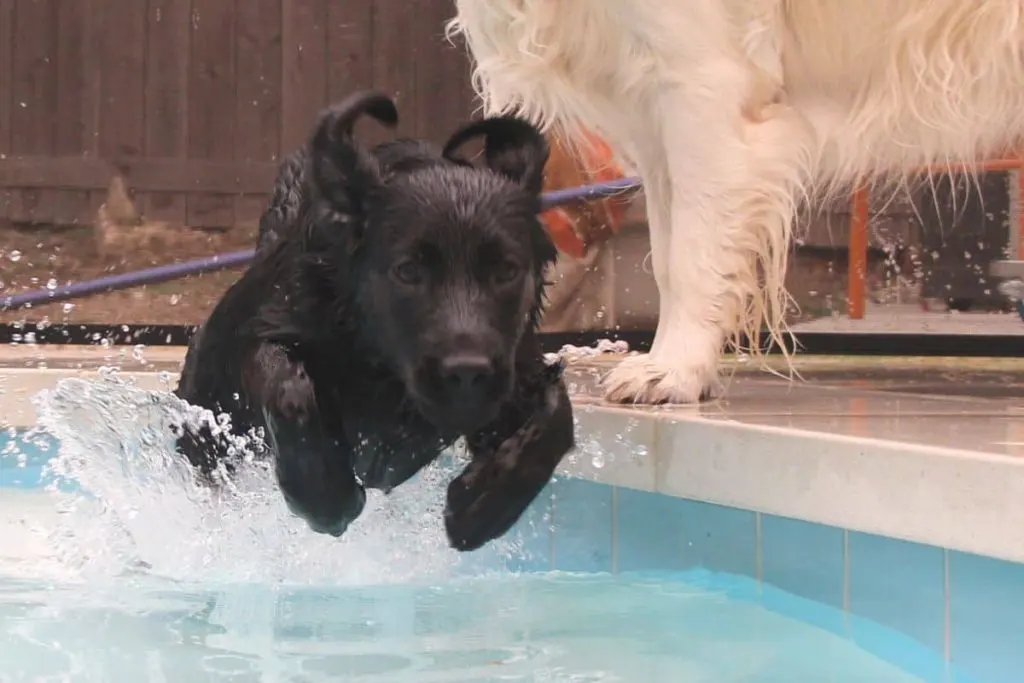The Labrador retriever is the most popular dog breed the #2 dog breed in the United States.
Why? Labs are intelligent, they learn quickly, and they are naturally friendly. They make great working dogs and wonderful household pets.
While we often think of the iconic yellow Lab, black is actually the most common color for Labradors, and these sleek, beautiful animals are the perfect choice for a canine companion to be your shadow.
Read on as I take you through everything you need to know about black Labrador retrievers and help you decide whether this is the right dog for you!
Basic Statistics
- Breed: Specific color variation within purebred line
- Weight: 55 to 70 pounds (female) 65 to 80 pounds (male)
- Height: 21.5 to 22 inches (female) 22 to 22.5 inches (male)
- Coat: Black (yellow and chocolate variations also available) thick double coat that is high shedding
- Life Expectancy: 10 to 12 years
- Intelligence: Highly intelligent, motivated to work, easy to train
- Temperament: Friendly, affectionate, likes children and other animals
- Energy Level: Very high
History Of The Breed
Labrador retrievers were first bred in the United Kingdom in the early 1800s from stock animals imported from Labrador in Canada.
They were bred to be gun dogs that could retrieve game downed both on the ground and over water.
For this, it was important that they had a soft mouth so they could gently pick up items without destroying them.
The initial stock was likely predominantly black, as this was the main color of the first Labs bred.
The chocolate color, which was called “liver” at the time, emerged only in the late 1800s, while the first yellow Labrador Retriever is only recorded in 1899.
The breed was recognized by the Kennel Club in the UK in 1903 and the American Kennel Club in 1917.
In the 20th century, Labrador retrievers emerged as one of the most popular breeds for working dogs. They are intelligent and easy to train, plus they enjoy working.
They breed is also naturally friendly and therefore does well in public spaces. Their decent size and strength and soft mouth are also beneficial factors.
They are often seen working as guide dogs for the blind or trained to help with other disabilities.
Famously, a lab named Endal was trained to place a wheelchair-bound man into the recovery position when needed, cover him with a blanket, and call emergency services.
According to American Kennel Club records, the Labrador retriever is currently the most popular dog breed as of 2023 the French Bulldog is the #1 dog breed. Labs have fallen to number 2 in the United States.
Appearance
Most people know what a Labrador retriever looks like because they are such popular dogs.
They are classified as medium to large in size, with the females 21.5 to 22 inches tall and the males 22.5 to 23 inches tall. Females weigh between 55 and 70 pounds, while the larger males are 65 to 80 pounds.
Labradors have a dense double coat with a short thick under layer and a longer over layer. This is designed to repel water, and Labs are great swimmers.
But this also means they are high shedding. Regular brushing is a must, and you can still expect dog hair to be a part of life.
Black Labrador retrievers are, of course, black in color. They are a full block color and this is the most common color. Well, not necessarily the most common color but black is the dominant gene in Labs. We’ll save the technical talk on Lab colors for another day.
They have a fairly sturdy and muscular physique with a broad head and rectangular ears.
You can actually get either American or English Labs, with the English variety being a little bit stockier and squarer.
Temperament
All Labrador retrievers are described as intelligent and friendly. They could probably also be described as being dependent, because they love to be around their people.
Labrador retrievers are considered among the smartest dog breeds.
They are ranked in the top ten for intelligence alongside breeds such as the Poodle, Border Collie, German shepherd, and Golden retriever.
A Lab may only need to be shown a new command 10 to 15 times to master it.
Labs are also highly motivated by praise and keen to please their humans. This makes them easy to train and control.
This is one of the reasons that they make better working dogs than other intelligent breeds with a more independent streak, such as Poodles.
Labradors are naturally friendly and they love people, children, and other animals. This makes them a great choice for families with children or other small animals, such as cats.
But they are terrible guard dogs, as they are more likely to make friends with a stranger entering the home than start barking.
Labs aren’t big barkers, and if they do get mouthy, it is a good idea to pay attention.
But the close bonds that Labradors develop with their families mean they don’t tolerate being left alone. Despite their large size, they can’t be outdoor-only dogs.
They need to feel like part of the family and be in the house close to the action.
They can also develop separation anxiety if they are left alone for long periods of time, for example, when everyone is at work and at school.
This can lead to destructive and aggressive behavior in these otherwise docile dogs. They do best if they can go to work with someone.
You can find our guide to identifying and managing separation anxiety in dogs here.
Exercise
Labrador retrievers, regardless of their color, are high-energy. They need lots of exercise to burn off energy and maintain their weight. They also love food, so this is important!
While they should not be outside-only dogs, they will do well if they have an outside space, such as a fenced in yard, that they can use throughout the day.
On top of this, they need at least an hour of formal exercise per day. A casual walk usually won’t cut it. They should have the opportunity to run and play.
However, it is important not to over-exercise Labrador retrievers when they are puppies.
While they are high-energy, too much exercise can result in growth issues that can lead to problems such as elbow and hip dysplasia.
When they are puppies, Labs should have five minutes of exercise for every month of their age. So, a four-month pup needs 20 minutes, and a six-month pup needs 30 minutes.
Once they hit a year, they can start getting their hour of daily exercise. Labradors love to swim, so take them to the lake and the beach with you!
You guessed it! Our black Lab, Elsa loves to swim!
Health
Labrador retrievers have a respectable lifespan for dogs of their size of 10 to 12 years. Smaller dogs tend to live longer, while larger dogs have shorter lifespans.
But as is common due to the limited gene pools or purebred pups, Labs can be predisposed to a number of medical conditions.
This is not to say that they will develop any of these conditions, but these are the things to monitor for with your vet.
Hip and elbow dysplasia are quite common in Labs, and controlling their exercise as a puppy can help prevent this.
Regardless, many Labs will develop mobility difficulties as they get older.
Eye conditions are also pretty common in Labrador retrievers, including progressive retinal atrophy and cataracts. You can expect a Lab to lose at least some of their sight in their senior years.
Another thing to worry about with black Labs is their weight, as they don’t have the appetite-regulating gene, which means they don’t know when they are full.
This is why it is essential to control their calorie intake.
An adult Labrador will need to eat around 1500 calories a day, but this should be adjusted up or down based on the size and energy levels of your dog.
The best thing you can do to get it right is monitor what they are eating and monitor their weight. They should have a diet that is high in animal-based proteins to give them the energy that they need to thrive.
Adopting A Black Labrador Retriever Puppy
Labrador retrievers are very popular, so there are lots of breeders working with them. Black is also the most common color, so it shouldn’t be difficult to find pups for sale.
If you are buying from a respectable breeder, you can expect to pay between $400 to $1,500 depending on the current supply and demand where you live.
Because black Labs are so popular, they also end up in shelters and rescues because of their numbers.
This is rarely because there is a problem with the dog, and usually because the person who adopted them was not prepared for the time and effort needed to care for them.
These dogs need homes, so it is great to look at shelters and rescues before looking for breeders.
FAQs
How rare is a black Labrador?
While the yellow Lab may be the poster child for the breed, black is actually the most common color for a Labrador retriever.
While black may be the most common color (probably because it’s the dominant gene) a good breeder can produce an all black, all yellow, all chocolate litter, or any mix of the three colors. It just takes a little understanding of genetics.
What is the difference between a black Lab and a Labrador retriever?
There is no difference between a black Lab and a Labrador retriever.
Black is one of the three color variations of labs, the others being chocolate and yellow.
Black is the most common color for labs.
Are black Labs aggressive?
Black dogs sometimes get a bad reputation because of their “sinister” color, but black Labs are just as friendly and affectionate as other labs.
They are never aggressive, unless they have been maltreated, and they are more likely to make friends with people, children, and animals than start barking at them.
Honestly, I never thought my black Lab looked sinister until I spoke with one of the blind handlers at our guide dog school. She said she preferred Black Labs because fewer people would approach her.
She didn’t say it was because of her guide dog’s sinister looks but obviously people were more averse to her black dogs.
Is A Black Lab The Right Dog For You?
Are you considering adopting a black Lab, but you aren’t sure if they are the right dog for you? Ask yourself the following questions.
- Are you experienced with dogs? This doesn’t really matter, as Labs are friendly and trainable, so they are a great choice for first-time owners.
- Do I have children or other pets? Again, if you do, a Lab might be the right dog for you because they get on great with kids and other pets. However, one thing to note, if you have smaller children a rambunctious Lab might have too much energy for your little ones. Sometimes young Labs don’t realize their size and they will sometimes knock over the little people.
- What kind of place do I live in? If you live in an apartment, you might struggle with a Lab because their size may make your space seem small, and they do benefit from outdoor space. But a small house with a little outdoor space and parks nearby is usually enough for a Black Lab. To be honest with you, our guide dog school has not restrictions regarding the size of your home. They will place Labs in small homes without yards, condos, and apartments as long as you are willing to walk and exercise your dog multiple times a day.
- Do I have time to spend with a dog? Labradors are the type of dogs that like to be around their people all the time. While this doesn’t mean you need to spend 24/7 together, if you are out of the house for 10 hours a day working and can’t take your dog with you, then a Lab is not a good match.
- Do I have an active lifestyle? Labrador retrievers need lots of exercise and do best with an active family who will enjoy engaging with their pup in activities.
If you don’t think you are compatible with a Labrador, you might want to consider a smaller and less energetic breed with a more independent personality who won’t suffer as much when left alone.
Are Black Labrador Retrievers Good Dogs?
Black Labrador retrievers are fantastic dogs. They are friendly and intelligent and make great family pets and companions, even for first-time owners.
But before you adopt, remember that they are big dogs that need lots of exercise.
They are also loving dogs that will want to be around you as much as possible and won’t thrive if left alone for extended periods of time.
To quickly recap, here are the breed’s key characteristics at a glance once more:
- Breed: Specific color variation within purebred line
- Weight: 55 to 70 pounds (female) 65 to 80 pounds (male)
- Height: 21.5 to 22 inches (female) 22 to 22.5 inches (male)
- Coat: Black (yellow and chocolate variations also available) thick double coat that is high shedding
- Life Expectancy: 10 to 12 years
- Intelligence: Highly intelligent, motivated to work, easy to train
- Temperament: Friendly, affectionate, likes children and other animals
- Energy Level: Very high
Are you thinking about getting a black Labrador Retriever?
Or maybe you already have one.
Tell us about your experiences in the comment section below.



